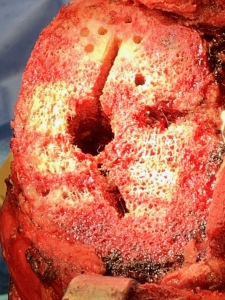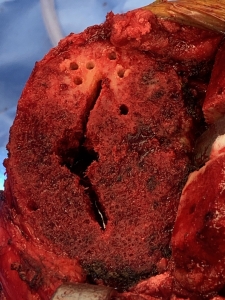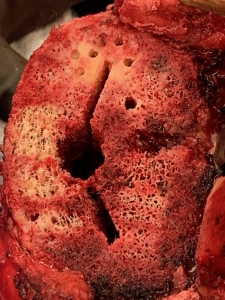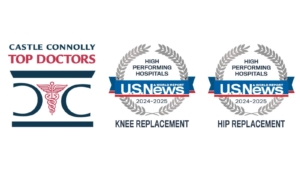No tourniquet total knee combined with novel device (CarboJet) improves implant stability.
Over the past year I’ve stopped using a tourniquet when performing total knee replacement (TKR). My decision to stop was based on a mounting body of evidence and in my hands and with my technique, the risks do not out weight the benefits. While my initial interest to stop using a tourniquet was to lessen post-operative pain and improve the experience; I see patients getting well even faster and going home from the hospital sooner with less pain and swelling, and less need for prolonged formal therapy than ever before. With less pain, there is less need for strong pain meds (narcotics) and thankfully patients no longer complain that their upper thigh is sore. My technique of performing TKR incorporates Verasense OrthoSensor and the CarboJet during preparation and final cementing. I’ll discuss both further later on.
Surgical Tourniquet
Verasense Orthosensor
CarboJet
Some patients develop a pronounced and prolonged post-operative swelling in their lower leg after total knee. This is more common when a tourniquet is used. This may be due to the development of a post-tourniquet syndrome characterized by edema (swelling), stiffness, pallor (patient looks pale), weakness without paralysis, pain and dysesthesia (unpleasant sensations) and numbness. While these symptoms are often attributed to surgical trauma or lack of patient motivation, sometimes they are due to tourniquet-related neuromuscular injury.
When the tourniquet pressure is released, a sudden return of blood to the limb occurs (called hyperemic). The lower limb tissues have been deprived of oxygen (ischemic) resulting in a buildup of lactic acid and other metabolic products of anoxia (no oxygen). This increased blood flow helps restore the normal acid-base balance and wash out these metabolic products. This sudden engorgement of blood also partially explains the increased swelling seen after tourniquet use.

Tibial surface prior to washing and drying
When a tourniquet is not used, vessels that are cut bleed and are immediately seen and coagulated. When a tourniquet is used, typically the cuff pressure is not released until the final components are cemented into place and then areas that bleed coagulate. Occasionally, a vessel is bleeding behind the newly placed prosthesis making it very difficult to control or significant bleeding develops in a delayed fashion after the wound is closed as blood pressure rises and blood again flows into a limb which has been starved of oxygen.
The development of a post tourniquet syndrome is more likely the longer a tourniquet is inflated (tissues left without oxygen) and when inadequate tourniquet pressure is used, particularly in the elderly. This is described as a “venous tourniquet”. Meaning the cuff pressure is only stopping venous blood flow. Tourniquet pressure is not high enough to block arterial blood flow into the limb but does block the venous blood flow out. This results in congestion and pooling of venous blood in the limb and particularly at the operative site making surgery more difficult and compromising the cement bond into the bone, and hence longevity. This is more common in elderly individuals whose blood vessels are often calcified and not as flexible. I also see this more frequently in patients who are overweight with very large fatty thighs. Patients who chronically take steroids (i.e. patients with rheumatoid arthritis) which can induce a vascular calcification and in those at increased risk of post-operative bleeding (i.e. bleeding disorders) may also be at increased risk for developing a post tourniquet syndrome.

After standard irrigation and drying
If a tourniquet is being used, I think it’s important that it is deflated before making final decisions regarding soft tissue releases to balance the soft tissue sleeve and patella tracking. Sometimes it’s necessary to release the lateral retinaculum (thick connective tissue that is part of the knee joint capsule and attaches to the outside of the knee cap) so the patella tracks centrally down the prosthetic trochlear groove (the groove in the front of the femoral component). Some surgeons elect not to deflate the tourniquet until the incision is completely closed and the dressing applied. From my experience using the OrthoSensor Verasense trial insert, which allows me to accurately quantitate specific loads on the soft tissue sleeve, I’ve gained a heighten insight regarding how much an inflated tourniquet affects these loads and patella tracking. This is because the tourniquet binds the thigh musculature including the quadriceps near the groin.
Optimally, cementing the total knee components is paramount to the long term TKR success. Total knee component loosening continues to a be major cause for failure and the need for revision surgery. Improved depth of cement penetration into the bony surface correlates with an improved mechanical interlock and implant stability. Traditionally the rational for using a tourniquet was to minimize bleeding into the cut “cancellous” (spongy) bone surface thereby improving cement penetration. There are conflicting study results comparing cement penetration in patients operated on with and without a tourniquet; however, there are no reported differences in implant migration (loosening) after two years.
After standard irrigation and drying
The goal when cementing the total knee components is to optimally prepare the bone by vigorously irrigating the cut bony surface to wash out any fat, blood or body fluid and then dry. Insuring that the patients’ blood pressure is low (another advantage of using a spinal or regional anesthetic), also helps keep the bone surface dry and improves the cement interdigitation.
Since I discontinued the use of a tourniquet in all my patients who I perform TKR, I’ve simultaneously added an additional method to further dry and clean the bone by using pressurized, filtered CO2 gas. It’s similar to how a dentist prepares and dries a tooth, using compressed air, prior to cementing in a “filling” or “implant.” The CO2 gas is delivered by a novel device called the CarboJet. Imagine that I’m “shooting” the cut, cancellous surfaces with this focal, pressurize column of CO2 gas after the initial irrigation and hand drying. I marvel at how much cleaner and optimized the bone surfaces then appear for cementation.

After CarboJet treatment, bone appears drier and spaces between trabecula appear more open and optimal to cement
I routinely share with patients that what has changed the most in my practice is how much faster and easier patients get well now than even a couple of years ago. Our multimodal pain management protocols have made a huge difference. My initial desire to stop using a tourniquet was to further improve my patient’s post-operative experience by decreasing post-operative pain and speeding up recovery while avoiding complications associated with using a tourniquet. I couldn’t justify this if the ultimate construct, that is, the prosthetic bone-interface was made weaker. Studies have shown that by further improving cement penetration using the CarboJet technique with compressed filtered sterile CO2 gas, cement penetration is better than when the TKR is performed using a tourniquet alone. Equivalent bone penetration was demonstrated when CO2 gas was used to further clean and dry bone surfaces prior to cementing in patients who underwent TKR both with or without the use of a tourniquet, but now without the potential complications of the tourniquet.
Tibial surface prior to washing and drying
Tibial surface following “standard” irrigation and drying
Tibial surface after CarboJet preparation, bone appears dryer and spaces between trabecula appear more open and optimal for cement
Check out Dr. Leone’s Patient Testimonials. These grateful patients make it all worthwhile.
Dr. William A. Leone is head of the Leone Center for Orthopedic Care at Holy Cross Hospital in Fort Lauderdale, Florida and has earned a reputation as one of the nation’s top orthopedic surgeons, solving complex hip and knee problems. Call 954-489-4575 or email us to schedule a consultation.










